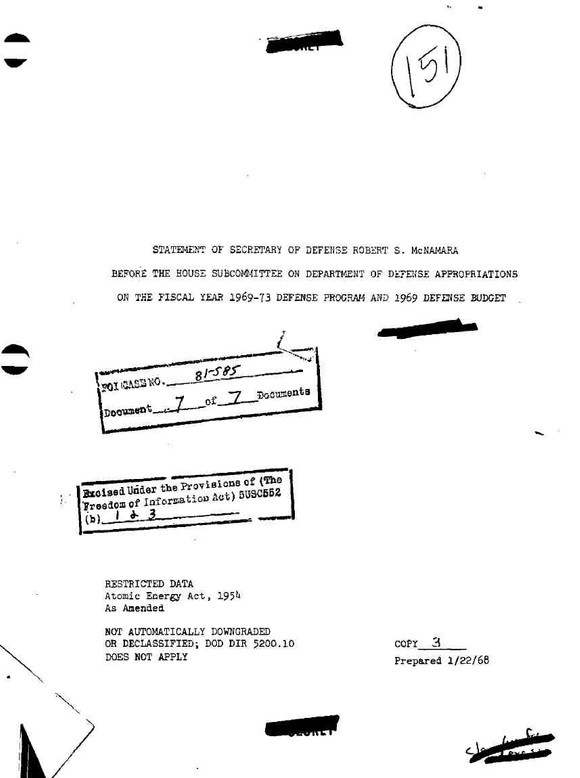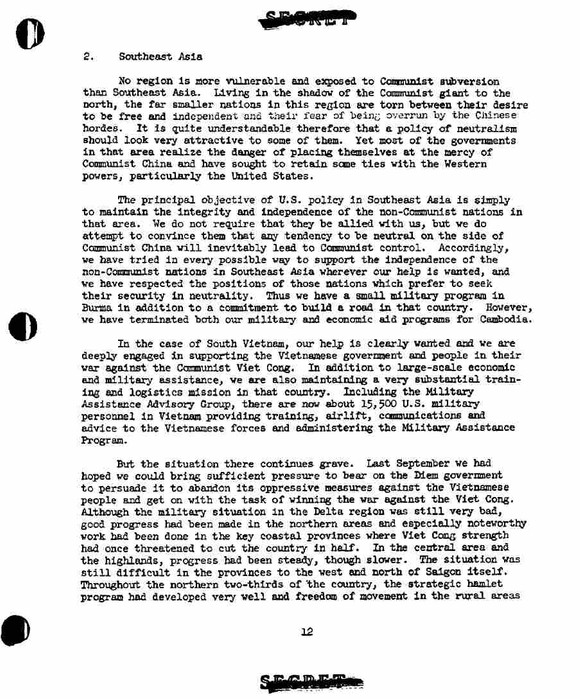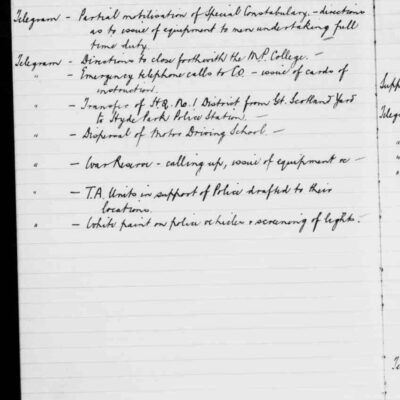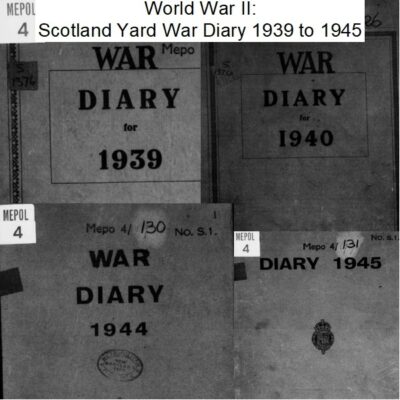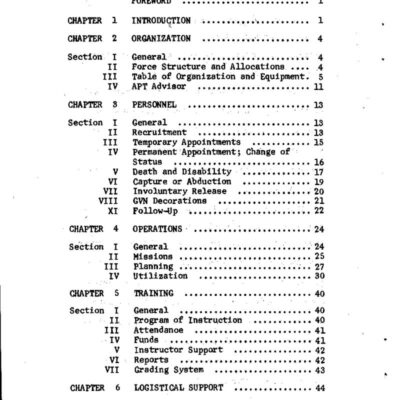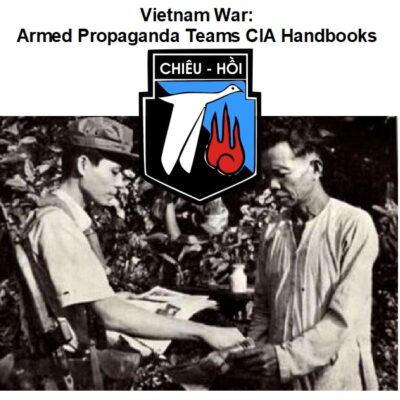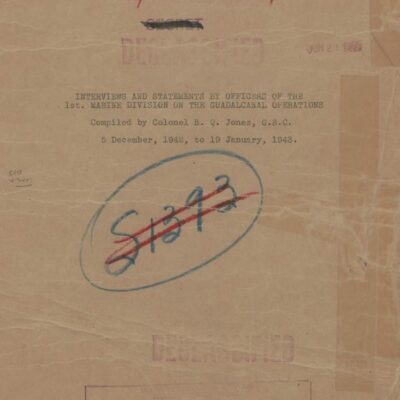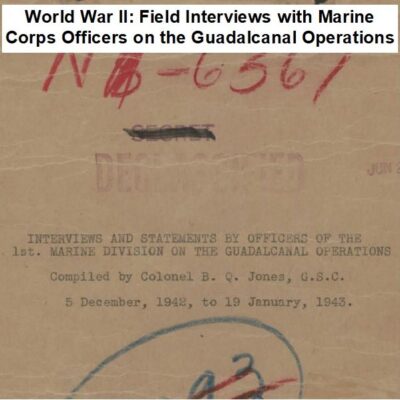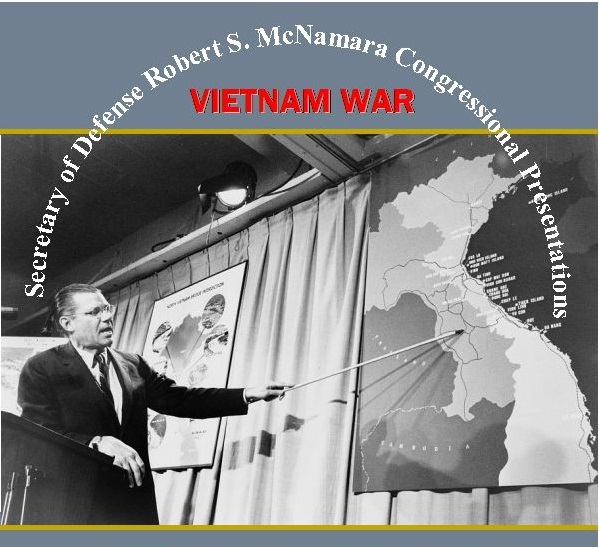
Vietnam War: McNamara’s Secret Congressional Presentations
$19.50
Description
McNamara’s Vietnam War Testimonies: 1962-1968
Timeline of Main Events (Based on McNamara’s Testimonies):
- 1962 – 1968: Secretary of Defense Robert S. McNamara makes seven appearances before various Congressional committees (Senate Subcommittee on Department of Defense Appropriations, Senate Armed Services Committee, and the House Armed Services Committee). These testimonies cover Department of Defense appropriations for fiscal years 1963-1972, defense budgets 1963-1969, and the defense program from 1963-1969.
- 1963 – 1969: The general focus of McNamara’s testimonies includes a wide range of Department of Defense matters, with the Vietnam War becoming increasingly prominent as the conflict escalates.
- 1964 (McNamara’s presentation to the Senate Armed Services Committee): McNamara states that the U.S. advisory effort in Vietnam cannot guarantee ultimate success, emphasizing that the war is fundamentally a Vietnamese one that they must fight and win. He mentions the policy of transferring U.S. responsibilities to the Vietnamese where possible without harming the overall war effort.
- 1965 (McNamara’s presentation to the Senate Armed Services Committee): McNamara acknowledges the grave situation in South Vietnam, citing increasing Viet Cong capabilities and losses of experienced South Vietnamese leaders and soldiers. However, he also notes encouraging developments, including the strengthening of South Vietnamese forces through new equipment, training, and operational experience. He reports progress in their operational planning, reaction time, and inter-Service coordination, expressing confidence in the combat performance of regular troops and noting improvements in recruiting and active duty strength towards the end of the year.
- Summer 1965: The source indicates this was the period when the U.S. decided to send combat forces to South Vietnam in response to the stepped-up efforts of the Communists.
- 1966 (McNamara’s testimony to the House Armed Services Committee): McNamara reiterates the reason for sending U.S. combat forces (increased Communist efforts to destroy South Vietnam). He states the U.S. is prepared to continue military collaboration with South Vietnamese forces as long as the Communists fight and is ready for further escalation. He also mentions a willingness to facilitate negotiations for a just settlement, but not a surrender of South Vietnam.
- Summer 1966 – Summer 1967: McNamara, in his 1967 testimony, reflects that the full dimensions of U.S. requirements for Southeast Asia were not clear during the previous summer. He highlights the uncertainty regarding the size and composition of required forces and their operational tempo, making it difficult to precisely determine future needs for personnel, supplies, aircraft losses, and construction. This uncertainty also made it challenging to estimate the additional funds needed for the remainder of the fiscal year.
- 1968 (McNamara’s presentation to the House Armed Services Committee): McNamara reflects on the significant increase in the military and economic strength of the U.S. and its allies since his first testimony in 1961. He also notes the growing difficulty and complexity of framing military policies due to accelerating trends that would significantly alter the world in the 1970s. He reaffirms the commitment to collective defense, exemplified by the involvement in Vietnam.
- Later in 1968 (McNamara’s testimony to the House Armed Services Committee): McNamara reiterates the complexity of the Vietnam problem, encompassing military, foreign policy, local political, economic, and social considerations. He notes a shift in the military task towards a more conventional limited war against external aggression. However, he emphasizes that the overall task remains enabling the South Vietnamese to cope with an externally directed and supported insurgency, rectify social ills, reestablish law and order, revive the economy, and create a viable, independent political structure.
- Throughout 1962-1968: McNamara’s testimonies consistently cover a broad range of defense-related topics beyond Vietnam, including the international situation (especially concerning Communist countries), military assistance and sales, nuclear war issues, the size and character of threats (Soviet and Chinese), U.S. force capabilities (strategic offensive and defensive, general-purpose), airlift and sealift, research and development, intelligence and communications, central supply and maintenance, training, personnel strengths and procurement, and cost reduction programs within the Department of Defense.
Cast of Characters:
- Robert S. McNamara: United States Secretary of Defense from 1961 to 1968 under Presidents John F. Kennedy and Lyndon B. Johnson. His testimonies to Congress during the Vietnam War provide significant insight into the decision-making processes and the evolving understanding of the conflict within the U.S. government. He played a key role in shaping U.S. military policy and strategy during this period.
- The Viet Cong: The armed wing of the National Liberation Front (NLF) in South Vietnam. They were a communist-led insurgent force that fought against the South Vietnamese government and, later, the United States. McNamara’s testimonies refer to their increasing capabilities as a key challenge.
- The South Vietnamese Armed Forces: The military forces of the Republic of Vietnam (South Vietnam). McNamara’s testimonies discuss their initial weaknesses, the U.S. efforts to strengthen them through equipment and training, and their progress in combat effectiveness over time.
- Communist Forces (in South Vietnam): A broader term encompassing the Viet Cong and potentially North Vietnamese forces operating in the South. McNamara refers to their stepped-up efforts to “destroy” South Vietnam.
- United States Forces (in Southeast Asia): The American military personnel deployed to South Vietnam and the surrounding region. McNamara’s testimonies detail the decision to send combat forces and discuss the evolving requirements and challenges faced by these forces.
- Allies (of the United States in Vietnam): Countries that contributed military or other forms of support to South Vietnam alongside the United States. McNamara mentions the U.S. working “in concert with our Allies.”
- The Communists (referring broadly to communist states and movements): Mentioned as the driving force behind the conflict in South Vietnam and a key factor in shaping U.S. military policies and programs globally. McNamara’s testimonies assess the capabilities and intentions of “Communist Countries” like the Soviet Union and Red China.
Vietnam War: Secretary of Defense Robert S. McNamara Secret Congressional Presentations
1,845 pages of once secret testimony by Secretary of Defense Robert S. McNamara to the United States Congress.
Once closed testimony to the United States Congress from 1962 to 1968. Seven appearances by Secretary of Defense Robert S. McNamara before the Senate Subcommittee on Department of Defense Appropriations, Senate Armed Services Committee, and the House Armed Services Committee. Testimony covers Department of Defense appropriations for the fiscal years 1963 to 1972, defense budgets 1963 to 1969, and the defense program from 1963 to 1969.
McNamara’s testimony covered the wide range of the Department of Defense’s existence. As the Vietnam War progressed, it became more prominent in his testimony.
Robert McNamara’s 1964 presentation to the Senate Armed Services Committee included this comment on the Vietnam War: “In this connection, we must recognize that the U.S. advisory effort cannot assure ultimate success. This is a Vietnamese war, and in the final analysis it must be fought and won by the Vietnamese. To leave our advisers there beyond the time they are truly needed would delay the development of Vietnam’s initiative. Therefore, it has been our policy to transfer U.S. responsibilities to the Vietnamese wherever this can be done without impairing the total war effort.”
In his 1965 presentation to the Senate Armed Services Committee, Robert McNamara’s comments on the Vietnam War included: “The present situation in South Viet Nam is grave but by no means hopeless. On the purely military side there remain a familiar series of problems — the increasing Viet Cong capabilities, and the losses of combat experienced South Vietnamese small unit leaders and soldiers. However, the past year has also brought some encouraging developments. The regular South Vietnamese forces have been considerably strengthened by the continuing flow of new equipment and by the additional training and operational experience. In open battle, the Vietnamese forces have shown encouraging progress in operational planning, in reaction time, and in inter-Service coordination. The combat performance of regular troops continues to inspire confidence and towards year’s end we noted Improvements in recruiting and in active duty strength.”
In his 1966 House Armed Services Committee testimony, Robert McNamara’s comments on the Vietnam War included: “Our decision to send U.S. combat forces to South Vietnam last summer was brought about by the stepped-up effort of the Communists to destroy that country. We are prepared to continue our military collaboration with the South Vietnamese forces as long as the Communists insist on fighting and we are ready to cope with any further escalation of the conflict on their part. In concert with our Allies and men of good will anywhere, we also stand ready to facilitate negotiations for a just settlement; but we have no intention of negotiating the surrender of South Vietnam.”
In his 1967 House Armed Services Committee testimony, Robert McNamara’s comments on the Vietnam War included: “First, we still could not see clearly last summer the full dimensions of our requirements for Southeast Asia. There was at that time a wide range of uncertainty concerning the size of the forces required, their composition and their tempo of operation. Consequently, we could not determine with any degree of precision how many more men we would need through the balance of the fiscal year, how much more ammunition and other supplies we would consume, how many more aircraft we would lose as, a result of enemy action, and how much more construction we would need in Vietnam and elsewhere to support the larger forces that might be required. Without these data, we could only guess the amount of the additional funds which would be needed for the balance of the fiscal year.”
In his 1968 House Armed Services Committee presentation, Robert McNamara’s comments on the Vietnam War included: “In the seven years since I first came before this Committee to testify on our defense programs, the military and economic strength of the United States and its allies has increased dramatically. But so have the difficulty and complexity of the problems we have had to face in framing our military policies. These years have seen the acceleration of a number of trends which will make the world of the 1970s very different from the world of the early 1960s. Today, as then, our military posture remains rooted in a commitment to collective defense. We and our allies are demonstrating this commitment every day in Vietnam. But today, and tomorrow, our country must be prepared to cope with a complex range of contingencies requiring forces and weapons systems with very diverse capabilities.”
Later in his 1968 House Armed Services Committee testimony, comments by Robert McNamara on the Vietnam War included: “Last year and the year before, I discussed in considerable detail our military objectives in Southeast Asia and the concept of operations developed to achieve them. However, it might be worth pointing out once again that we are dealing here with an immensely complicated problem, involving not only our immediate and longer range military and foreign policy objectives, but also local political, economic and social considerations as well. While the military task in Vietnam is beginning to assume some aspects of a conventional limited war against overt external aggression, our over-all Vietnam task remains that of making it possible for the South Vietnamese to cope with and suppress an insurgency which is externally directed and supported; to rectify the social ills on which that insurgency battens; to reestablish law and order; to revive and sustain the economy; and to create a viable, independent political structure.”
Topic and sub-topics covered in Secretary of Defense Robert S. McNamara’s testimonies to Congress included:
VIETNAM WAR – SOUTHEAST ASIA: The Communist Forces in South Vietnam. The South Vietnamese Armed Forces. Other Free World Forces in South Vietnam. U.S. Forces in Southeast Asia. Vietnam Related Personnel Matters.
ASSESSMENT OF THE INTERNATIONAL SITUATION AS IT BEARS ON MILITARY POLICIES AND PROGRAMS: The Communist Countries: The Soviet Union, Red China, Southeast Asia and Southwest Pacific Area, Northeast Asia, South Asia, Middle East, Africa, Indian Ocean, Latin America, Europe and the NATO Area, United Nations.
MILITARY ASSISTANCE AND SALES
THE GENERAL NUCLEAR WAR PROBLEM
THE SIZE AND CHARACTER OF THE THREAT: The Soviet Strategic Offensive-Defensive: Forces, Intercontinental Ballistic Missiles, Submarine-Launched Ballistic Missiles, Manned Bombers, MRBMs/IRBMs, Manned Interceptors, Surface-to-Air Missiles. Anti-Ballistic Missile Defense. Red Chinese Nuclear Threat.
CAPABILITIES OF THE PROPOSED U.S. FORCES FOR “ASSURED DESTRUCTION”: Capability Against the “Highest Expected Threat” in the NIE, Capability Against “Greater-Than-Expected Threats”
CAPABILITIES OF THE PROPOSED FORCES FOR DAMAGE LIMITATION: Anti-Ballistic Missile Defense, Defense Against the Red Chinese Nuclear Threat. Deployment of NIKE-X for Defense of Our Cities Against Soviet Attack. Anti-Bomber Defense.
STRATEGIC OFFENSIVE FORCES: Missile Forces: MINUTEMAN, TITAN II, POLARIS-POSEIDON, New Strategic Missile Systems. Strategic Bomber Forces.
STRATEGIC DEFENSIVE FORCES: Bomber Defense: Surveillance, Warning and Control, Manned Interceptors, Surface-to-Air Missiles. Missile and Space Defense: Missile Warning, Anti-Ballistic Missile Defense (SENTINEL). Anti-Satellite Defense.
CIVIL DEFENSE
CAPABILITIES OF THE GENERAL-PURPOSE FORCES: Land Forces. Tactical Air Forces. Anti-Submarine Warfare Forces: Submarines, Air ASW Forces, ASW Escorts. Fleet Anti-Air Warfare. Amphibious Assault. Theater Nuclear Forces.
ARMY GENERAL PURPOSE FORCES: Division/Brigade Forces. Supporting Forces. Army Procurement. Reorganization of the Army. Reserve Components.
NAVY GENERAL PURPOSE FORCES: Attack Carrier Forces: Ships, Carrier Aircraft. ASW Forces: ASW Carriers, Attack Submarine Forces, Patrol Aircraft, Sonobuoys, Torpedoes. Fleet Escorts. Amphibious Assault Ships. fire Support Ships. Mine Countermeasure Force. Logistics, Operational Support, and Direct Support Ships. Marine Corps Forces. Navy and Marine Corps Reserve Forces.
AIR FORCE GENERAL PURPOSE FORCES: Fighter and Attack. Tactical Reconnaissance. Tactical Electronic Warfare Support. Night Warfare. Special Air Warfare Forces. Tactical Air Control. Tactical Missiles. Air National Guard. Theater Air Base Vulnerability.
AIRLIFT AND SEALIFT FORCES: STRATEGIC MOVEMENT: TACTICAL MOVEMENT: AIR FORCE AIRLIFT: Active Forces, Air Force Reserve, Air National Guard. NAVY AIRLIFT. SEALIFT.
RESEARCH AND DEVELOPMENT: OVERALL POLICY MATTERS, THE DEPARTMENT OF DEFENSE SPACE PROGRAM.
NUCLEAR TESTING AND TEST DETECTION
SPACE DEVELOPMENT PROJECTS: Spacecraft Mission Projects. Vehicle, Engine and Component Developments. Other Defense Activities Supporting the Space Program.
EXPLORATORY DEVELOPMENT: Army. Navy. Air Force. Advanced Research Projects Agency (ARPA): Project DEFENDER. Project VELA. Project AGILE.
INTELLIGENCE AND COMMUNICATIONS: Intelligence and Security. National Military Command System. Communications. Other Specialized Activities: Weather Service. Oceanography. Air Rescue and Recovery. Nuclear Weapons.
CENTRAL SUPPLY AND MAINTENANCE
TRAINING, MEDICAL AND OTHER: Training: Recruit Training, Technical Training, Professional Training, Pilot
Training, Service Academies. Medical Services. Retirement.
ADMINISTRATION AND ASSOCIATED ACTIVITIES: Contingencies. Claims.
PERSONNEL STRENGTHS: Civilian Personnel Strengths. Military Personnel Strengths.
MANPOWER PROCUREMENT: MILITARY COMPENSATION. SPECIAL MILITARY MANPOWER MATTERS: “Project 100,000”
THE DOD COST REDUCTION PROGRAM: BUYING ONLY WHAT WE NEED: Refining Requirements Calculations, Increased Use of Excess Inventories, Eliminating Goldplating through Value Engineering, Inventory Item Reduction. BUYING AT THE LOWEST SOUND PRICE: Shift from Non-competitive to Competitive Procurement, Shift from Cost-Pius-Fixed-Fee (CPFF), Fixed-Price or Incentive Contracts, Multi-Year Procurement, The Contractor Program. REDUCING OPERATING COSTS: Terminating Unnecessary Operations, Consolidation and Standardization of Operations, Increasing Efficiency of Other Support Operations.
The files contain a text transcript of all recognizable text embedded into the graphic image of each page of each document, creating a searchable finding aid. Text searches can be done across all files in the collection.
